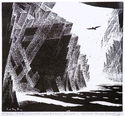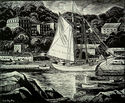
19th, 20th & 21st Century Fine Prints
707-546-7352 · fax 707-546-7924 · web: www.annexgalleries.com · email: artannex@aol.com
Carroll Thayer Berry Biography
Carroll Thayer Berry
American
1886–1978
Biography
Carroll Thayer Berry was born in New Gloucester, Maine on September 4, 1886. In 1905, reluctant to follow a farming career, he enrolled at the University of Michigan with the intention of becoming a marine engineer. After completing his undergraduate work, he moved back to New England, where he worked as a mechanical draftsman.
In 1910, Berry joined an architectural firm in Portland, Oregon, and was sent to Panama to participate in the construction of the canal. After a year, however, he contracted malaria and was sent back to the United States to recuperate. While in the U.S., he began to take art classes at the Pennsylvania Academy of Fine Arts.
in 1915, he moved to New York, where he earned his living as a commercial artist. Soon after, he married, and he and his wife raised a son. In 1917 he volunteered to serve in the army during World War I, where he worked as a camouflager. After World War I, Berry settled in Chicago, where he worked as a designer of installations and interiors for office buildings. He also met his second wife, Jane Scott, a successful illustrator, who later designed Raggedy Andy dolls and books about the Bobbsey twins.
During the Depression, Berry and his wife left Chicago and moved back to New England, where they bought a house in Wiscasset, Maine. Their home became a meeting place for craftsmen and artists of the region. The Berrys sold their house in Wiscasset following World War II and bought a home in Rockport, Maine, as well as an old three-story brick building on Main Street (just a short walk from their home), which served as Berry's studio for the rest of his life. It was there, equipped with a 19th-Century printing press, that Berry perfected his printmaking skills, in the process of which he made use of wood engraving, woodcut and linoleum block.
Berry's work is sometimes said to fall within three distinct periods: His early linocuts and oil paintings are experimental, and reflect the changing artistic trends of the early 1900s. In the era of the Depression, he turned to the more affordable medium of the woodblock, which eventually evolved into the iconic style of his wood engravings. Finally, around 1973, his interests shifted to Jay Hambidge's theory of dynamic symmetry, a system of proportion and natural design that promoted the use of geometry in artistic compositions.
On January 20, 1978, at age 91, Carroll Thayer Berry died in a Rockport, Maine hospital.





